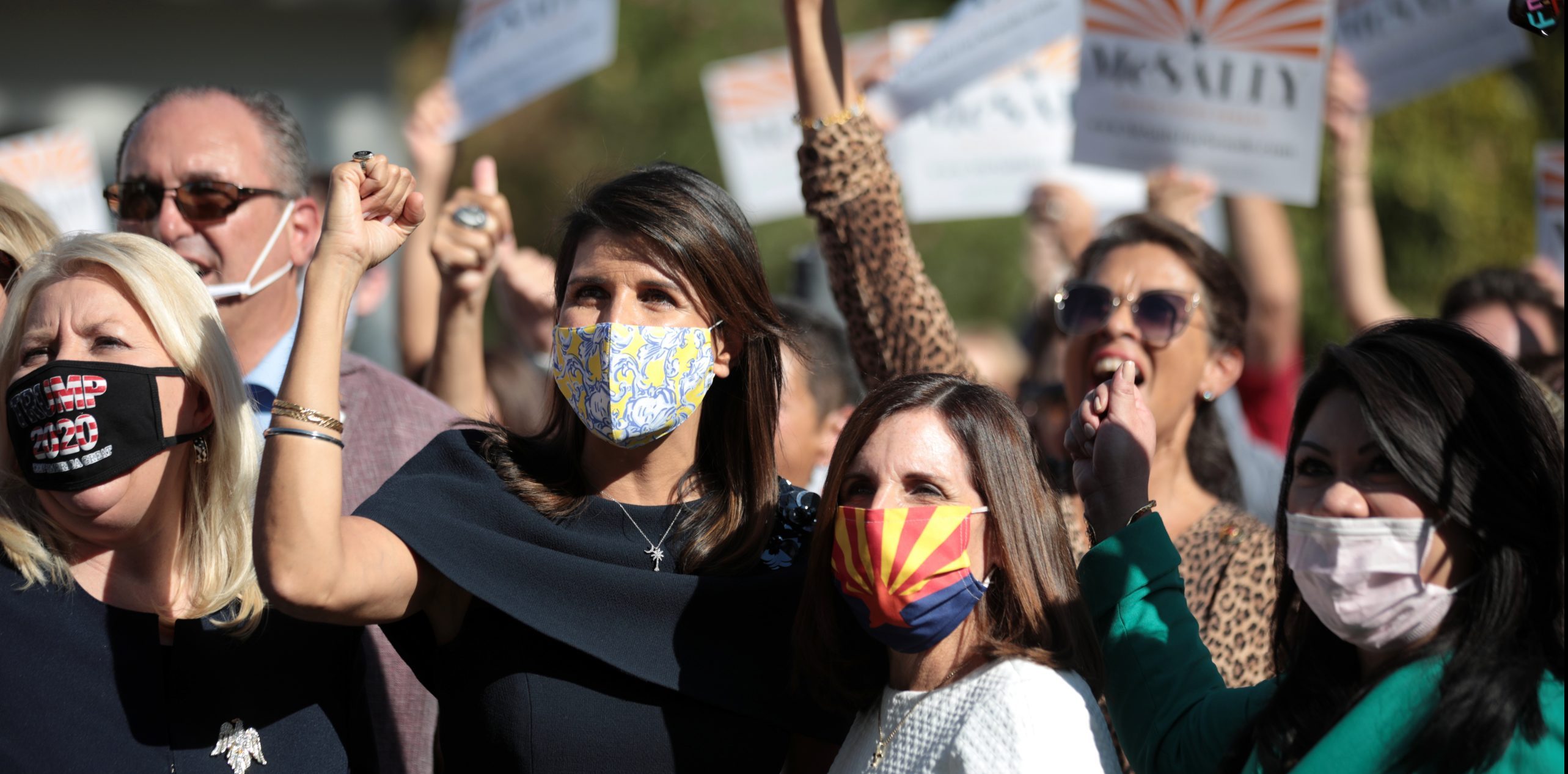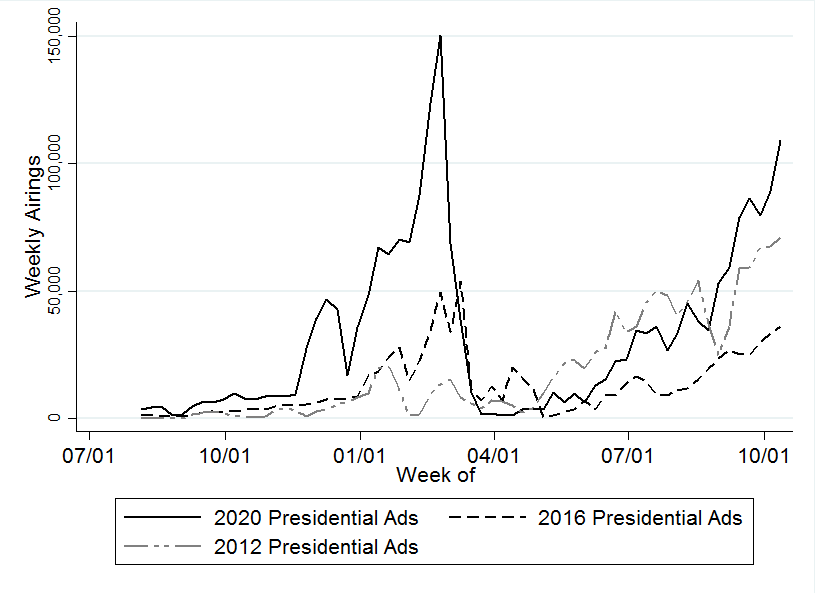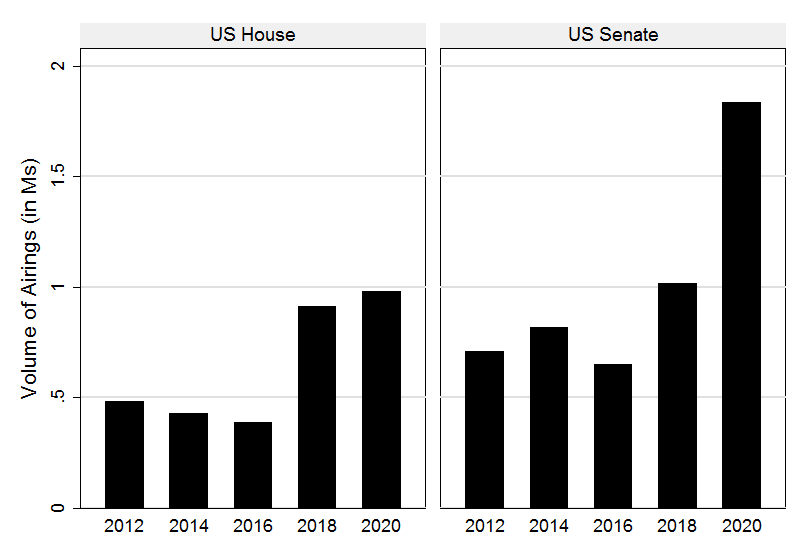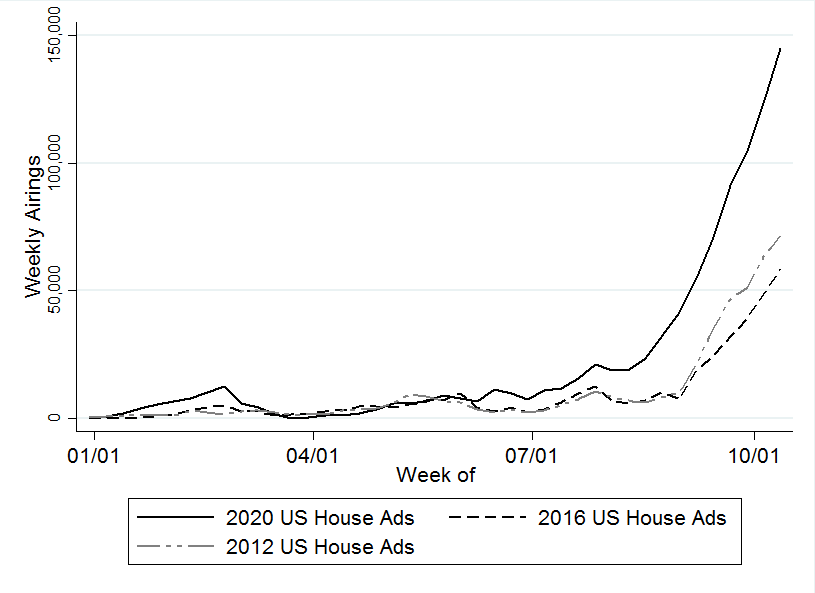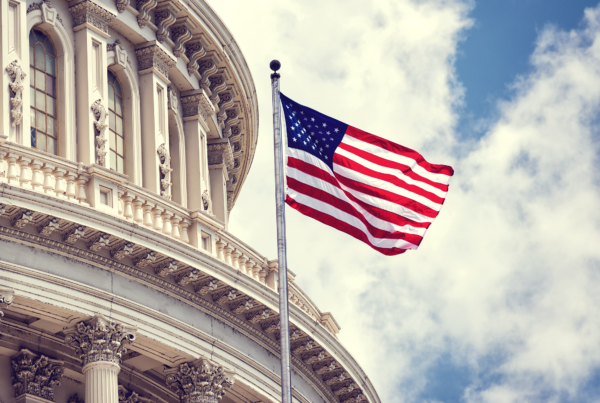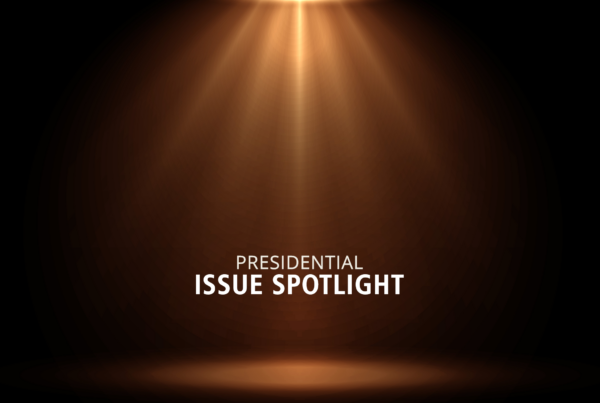Photo: Gage Skidmore/Flickr
Phoenix Top Media Market Cycle-to-Date
(MIDDLETOWN, CT) October 21, 2020 – A new brief report from the Wesleyan Media Project finds record levels of television advertising in the 2020 campaigns. Over 4.9 million ads have aired in federal races (House, Senate and president) on broadcast and national cable television since January of 2019 (Figure 1). That volume is more than twice the volume of ad airings in the 2012 and 2016 presidential election cycles—and well above the previously record-setting mid-term election ad volumes in 2018.
Figure 1: Volume of Federal Advertising by Cycle (2012-2020)
Numbers include all federal ads aired on broadcast television and national cable between January 1 of the off-cycle year and October 18 of the election year.
CITE SOURCE OF DATA AS: Kantar/CMAG with analysis by the Wesleyan Media Project.
Figure 2 shows where that federal advertising has been concentrated since January 1, 2019 and September 8, 2020 through October 18, 2020, with darker colors indicating media markets with more advertisements. Looking cycle-to-date, the market with the most ad airings—over 145,000—was Phoenix, Arizona. Charlotte, North Carolina (102,000 ad airings), and Des Moines, Iowa (just over 100,000 ad airings), are number two and three on the list. For just the period since September 8, Phoenix has also seen the most ad airings (over 52,000). Atlanta and Charlotte come in second and third (each with about 36,000 ad airings).
Figure 2: Ad Volume in Federal Races by Media Market (since January 1, 2019 and September 8)
Numbers include ads aired on broadcast television (excluding national cable airings) between January 1, 2019 and October 18, 2020, and between September 8 and October 18, 2020.
Totals include candidate, party, and group-sponsored ads.
Figure by Delta Lab’s Spencer Dean ’21 and Kevin McMorrow ’20
Click here to download the data in this figure.
Presidential Ads Spike in March, Recent Weeks
The volume of televised advertising in the 2020 presidential race continues to outpace the volume in 2012 and 2016—and the rate of the increase only seems to be increasing (Figure 3). Heavy ad volumes between January and March, reflecting record-setting presidential primary spending (largely from former candidates Michael Bloomberg and Tom Steyer), and in the past two months, account for the unprecedented presidential ad volumes in 2020.
Figure 3: Number of Presidential Ad Airings by Week (2012, 2016 and 2020)
Numbers include ads aired on broadcast television and national cable between July 1, 2019 and October 18, 2020.
Click here to download the data in this figure.
CITE SOURCE OF DATA AS: Kantar/CMAG with analysis by the Wesleyan Media Project.
Unmatched ad volumes are also evident in Senate races, though less so in the House (Figure 4). Over 1.8 million Senate ads have aired in this election cycle, nearly doubling the one million Senate ads that aired in the 2017-2018 election cycle. House ads this cycle are up slightly over 2017-2018 (983,000 v. 911,000).
Figure 4: Volume of Congressional Ad Airings by Cycle (2012-2020)
Numbers include ads aired on broadcast television and national cable between January 1 of the off-cycle year and October 18 of the election year.
CITE SOURCE OF DATA AS: Kantar/CMAG with analysis by the Wesleyan Media Project.
Senate ads approached 175,000 in the most recent week, whereas the number ads at this time in 2012 and 2016 were only about 65,000 per week (Figure 5).
Figure 5: Number of U.S. Senate Ad Airings by Week (2012, 2016 and 2020)
Numbers include ads aired on broadcast television between January 1 and October 18, 2020.
Click here to download the data in this figure.
CITE SOURCE OF DATA AS: Kantar/CMAG with analysis by the Wesleyan Media Project.
The number of House ads has also shot past numbers from 2012 and 2016 in recent weeks (Figure 6).
Figure 6: Number of U.S. House Ad Airings by Week (2012, 2016 and 2020)
Numbers include ads aired on broadcast television between January 1 and October 18, 2020.
CITE SOURCE OF DATA AS: Kantar/CMAG with analysis by the Wesleyan Media Project.
About This Report
The Wesleyan Media Project (WMP) provides real-time tracking and analysis of political advertising in an effort to increase transparency in elections. Housed in Wesleyan’s Quantitative Analysis Center (QAC) – part of the Allbritton Center for the Study of Public Life – the Wesleyan Media Project is the successor to the Wisconsin Advertising Project, which disbanded in 2009. It is directed by Erika Franklin Fowler, associate professor of government at Wesleyan University, Michael M. Franz, professor of government at Bowdoin College and Travis N. Ridout, professor of political science at Washington State University. WMP personnel include Laura Baum (Project Manager), Colleen Bogucki (Project Coordinator), Pavel Oleinikov (Associate Director, QAC), Markus Neumann (Post-Doctoral Fellow), and Jielu Yao (Post-Doctoral Fellow).
The Wesleyan Media Project’s digital advertising tracking is supported by the contributions of students in Delta Lab, an interdisciplinary research collaborative focusing on computationally-driven and innovative analyses and visualizations of media messaging. We especially thank Spencer Dean ’21 for his contributions to this report.
The Wesleyan Media Project is supported by Wesleyan University, the John S. and James L. Knight Foundation, and the Democracy Fund. WMP is partnering again this year with the Center for Responsive Politics, to provide added information on outside group disclosure.
Periodic releases of data will be posted on the project’s website and dispersed via Twitter @wesmediaproject. To be added to our email update list, click here.
For more information contact: Lauren Rubenstein, lrubenstein@wesleyan.edu, (203) 644-7144
About Wesleyan University Wesleyan University, in Middletown, Conn., is known for the excellence of its academic and co-curricular programs. With more than 2,900 undergraduates and 200 graduate students, Wesleyan is dedicated to providing a liberal arts education characterized by boldness, rigor and practical idealism. For more, visit wesleyan.edu.
About the John S. and James L. Knight Foundation Knight Foundation is a national foundation with strong local roots. We invest in journalism, in the arts, and in the success of cities where brothers John S. and James L. Knight once published newspapers. Our goal is to foster informed and engaged communities, which we believe are essential for a healthy democracy.
About Democracy Fund Created by eBay founder and philanthropist Pierre Omidyar, Democracy Fund is a foundation helping to ensure that our political system can withstand new challenges and deliver on its promise to the American people. Democracy Fund has invested more than $125 million in support of a healthy, resilient, and diverse democracy with a particular focus on modern elections, effective governance, and a vibrant public square.

